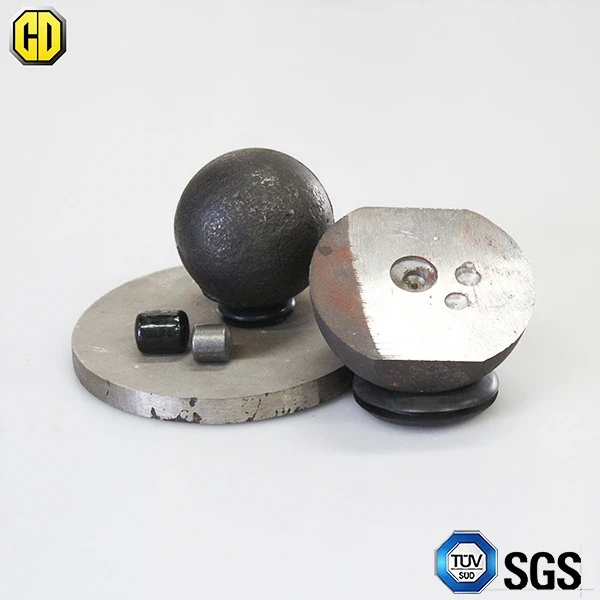Oct . 02, 2025 15:25 Back to list
High Chrome Grinding Media: Wear-Resistant, Cost-Saving?
If you’ve spent time in a mill—cement, mining, or even a refractory line—you know the quiet economics of wear. That’s why many purchasing teams now start by searching high chrome grinding media instead of generic “balls.” To be honest, the performance delta is getting too obvious to ignore.
High Chrome Grinding Ball: a quick insider’s view
Origin: KIZUN Industry Zone, Luquan, Sihijiazhuang city, Hebei, China. I visited that cluster a few years back; lots of sand molding shops, a few serious heat-treatment lines, and—surprisingly—decent in-house metallography.

Where they’re used
Cement finish mills, raw mills, copper/gold/iron ore concentrators, power plant desulfurization lines, and the odd chemical or petroleum grinding unit. Many customers say the switch from low-Cr forged to high chrome grinding media cut their top-up rate by a third—your mileage may vary with feed hardness and mill parameters.
At-a-glance specs
| Product | High Chrome Grinding Ball |
| Size Range | 10–140 mm |
| Chrome (Cr) | 10–28% (typical) |
| Matrix / Carbides | Martensitic matrix with M7C3 carbides |
| Hardness | Surface ≈ HRC 62–67; Core ≈ HRC 58–64 |
| Density | ≈7.6–7.8 g/cm³ |
| Use Cases | Construction machinery, chemical, petroleum, refractory material, cement plant, mining mill |
Process flow (how they’re actually made)
- Materials: High-Cr white iron charge; tuned C (≈2.0–3.2%), Cr (10–28%), with Mo/Ni/Cu micro-alloying for hardenability.
- Methods: Sand or automatic molding; precise gating; controlled pouring temperature to avoid shrinkage.
- Heat treatment: Quench and temper cycle to achieve martensitic matrix; tempering to relieve stress and stabilize hardness.
- Testing standards: Chemical per heat (spark OES); hardness mapping; drop-ball test (6 m) to 10,000+ cycles; abrasion benchmarks per ASTM G65; material conformance per ASTM A532.
- Certificates: ISO 9001:2015 QMS; mill test certificates to EN 10204 3.1 upon request.
Real-world service life? In cement finish mills, I’ve seen high chrome grinding media deliver around 1.5–3.0× longer life than low-Cr forged, with wear rates ≈25–60 g/t (feed-dependent). In harder ore circuits, expect more variability, honestly.
Vendor comparison (field-notes style)
| Vendor | Hardness Consistency | Typical Wear (cement) | Certification | Lead Time |
|---|---|---|---|---|
| Chengda (Hebei) | Tight (surface/core ≈±2 HRC) | ≈25–45 g/t (real-world use may vary) | ISO 9001; EN 10204 3.1 | Around 3–5 weeks |
| Generic Import | Mixed (±4–6 HRC) | ≈40–70 g/t | Supplier-declared | 6–10 weeks |
| Local Foundry | Good when audited | ≈35–60 g/t | Varies | 2–6 weeks |
Customization that actually helps operations
- Size mix: 10–140 mm; graded charge optimization for first/second chamber cement mills.
- Chemistry: Cr 10–28% tuned to ore abrasion/impact profile; Mo for section depth; Ni for toughness.
- Heat-treatment curve: Adjusted to reduce spalling in high-impact SAG environments.
- Packaging: Ton bags or drums; magnetic sweeping and sorting to keep tramp low. Color: black as-cast/tempered.
Case snapshots
Cement, SE Asia: 3.2×13 m finish mill. After switching to high chrome grinding media, liner scuffing dropped and ball charge top-up shifted from 90 t/month to about 58 t/month; Blaine held steady at 3400 cm²/g.
Gold ore, LATAM: Feed P80 ≈150 µm, Ai moderate. Breakage rate improved slightly, but the big win was fewer broken balls (drop test >10,000 cycles, no catastrophic failures observed).
Quality & documentation
- Heat-by-heat OES chemistry reports and hardness maps.
- EN 10204 3.1 MTCs and lot traceability.
- Wear tracking templates so plants can quantify savings (I can share a simple spreadsheet—ping me).
Bottom line: if you’re aiming for a cleaner grind curve and fewer surprises, high chrome grinding media are a pragmatic upgrade—especially where abrasion dominates impact.
- ASTM A532/A532M – Standard Specification for Abrasion-Resistant White Iron Castings.
- ASTM G65 – Standard Test Method for Measuring Abrasion Using the Dry Sand/Rubber Wheel Apparatus.
- ISO 9001:2015 – Quality Management Systems Requirements.
- EN 10204:2004 – Metallic products, Types of inspection documents (Type 3.1).
-
Expert Insights on Fabrica de Molinos de Bolas: Industry Trends & Global Applications
NewsNov.24,2025
-
Expert Insights on Fabricantes de Bolas de Molienda de Acero: Global Applications & Trends
NewsNov.23,2025
-
Leading Fabricantes de Bolas de Molienda: Your Ultimate Guide to Grinding Balls
NewsNov.23,2025
-
Fabricante de Bolas de Molienda – Quality Grinding Balls for Efficient Industry
NewsNov.23,2025
-
Trusted Proveedores de Medios de Molienda for Efficient Industrial Grinding
NewsNov.22,2025
-
Proveedores de Bolas de Molienda: Your Guide to Top Grinding Ball Suppliers & Industry Insights
NewsNov.22,2025
Realted Products
















